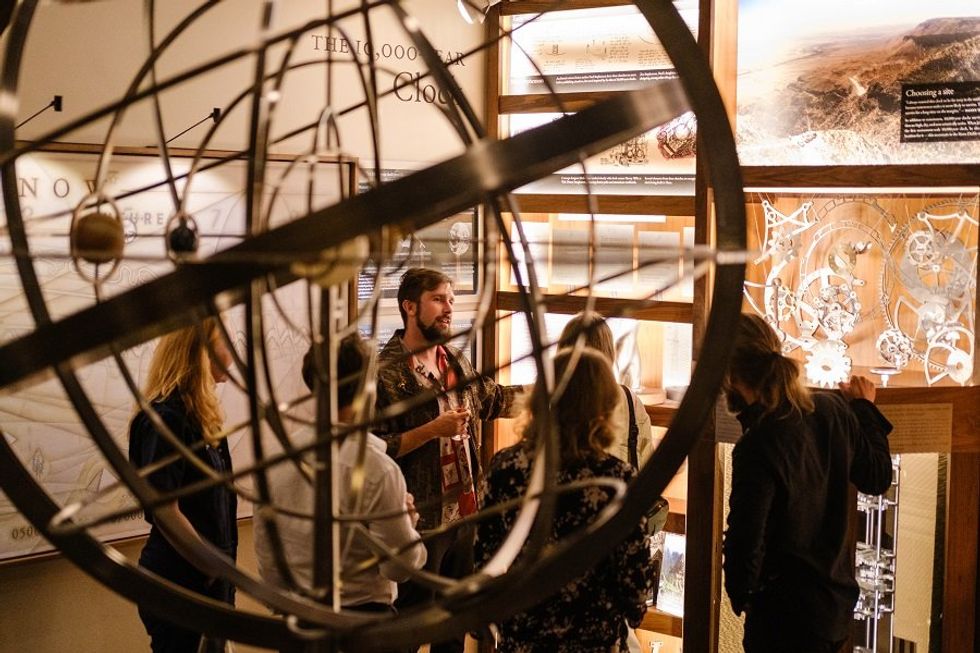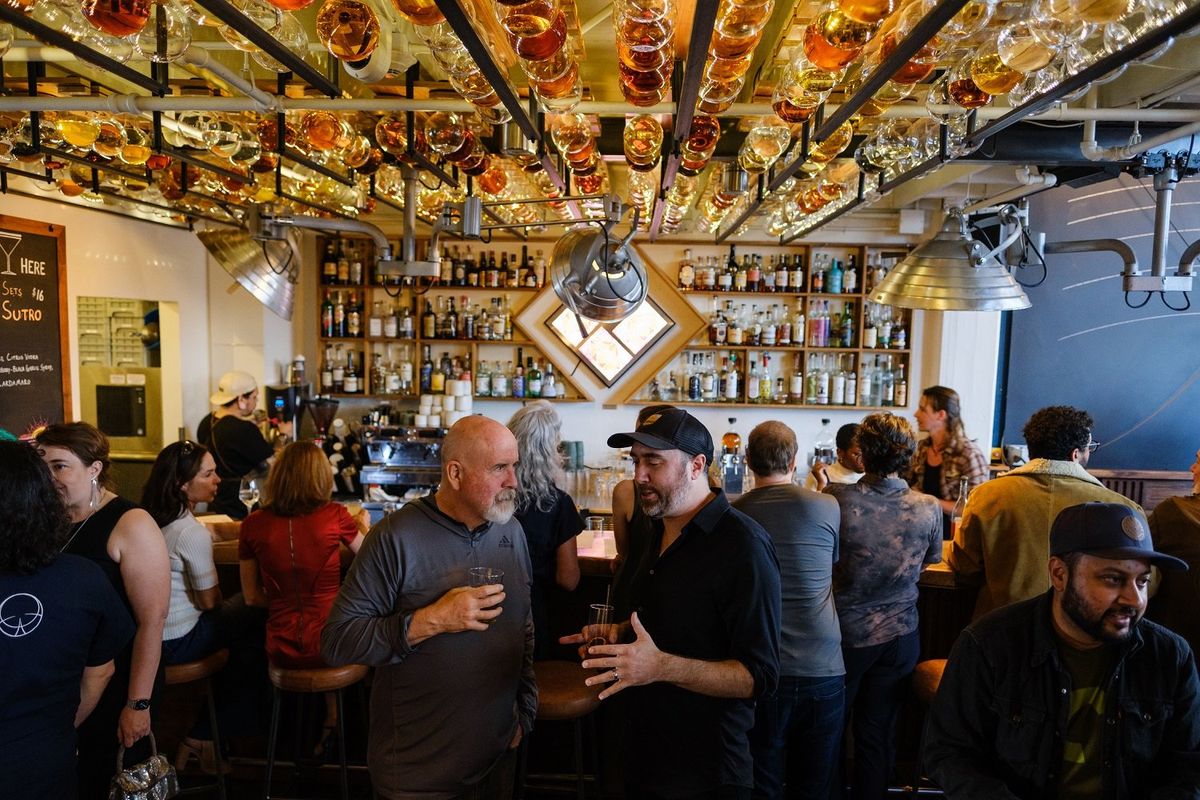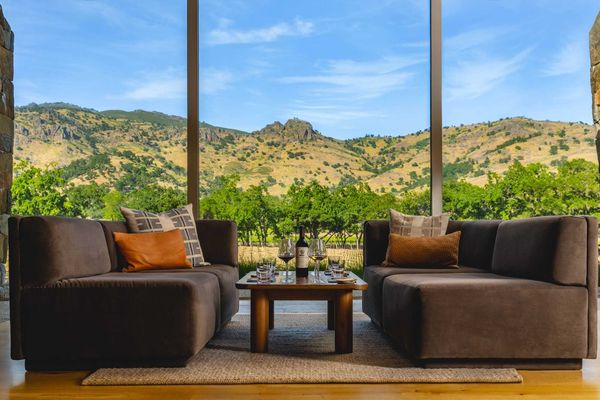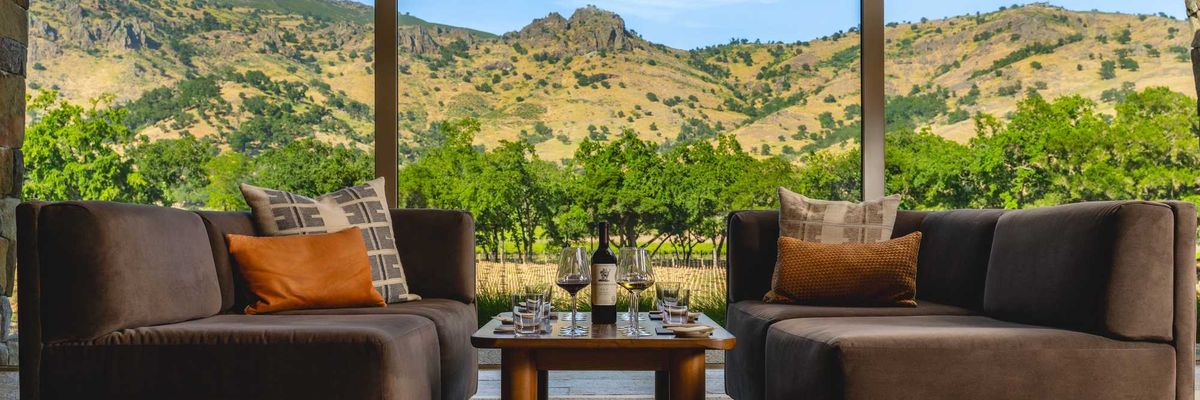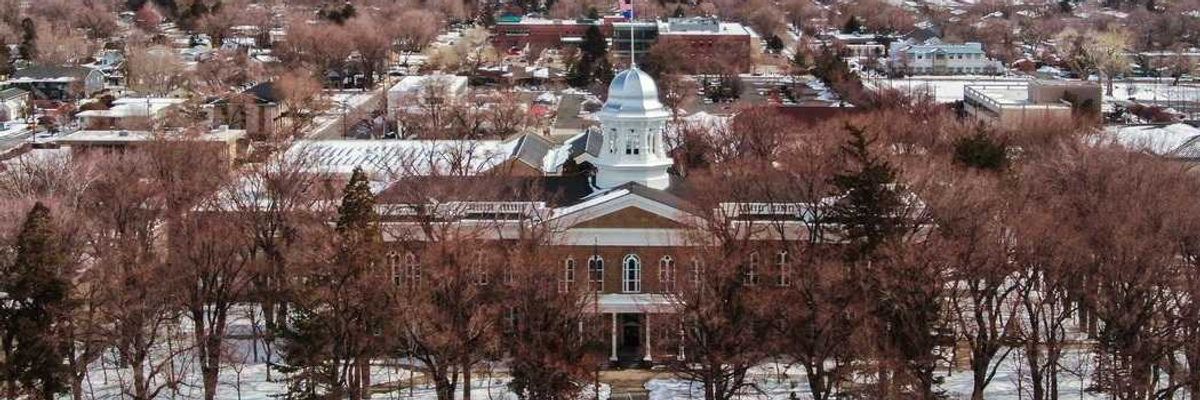Humanity’s most precious knowledge lives at a bar in Fort Mason.
The collection, the Manual for Civilization, includes all the practical, philosophical, and cultural information we’d need to rebuild civilization on Earth if the worst were to happen.
It’s one of several projects that burrow into the mysteries and inevitabilities of deep time headquartered at The Interval, the coffee-bar-by-day, cocktail-bar-by-night museum/salon operated by the Long Now Foundation.
Like the coffee houses of the Enlightenment Age, The Interval serves as the nerve center around which the organization and their mission—to provoke thought and imagination about what they call the “long now,” the timespan stretching 10,000 years into the past and 10,000 years into the future—revolves.
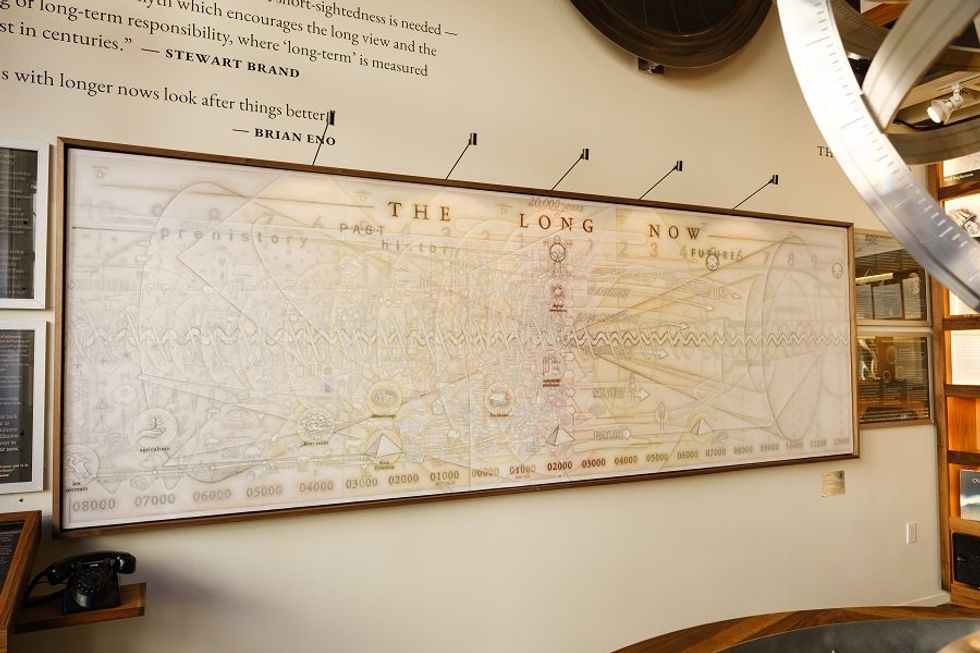
This year, on The Interval’s 10th anniversary, the foundation has redesigned the bar’s interior to put those objectives front and center. Artifacts, signage, and interactive elements now wind through the space with a self-guided audio tour that can be dialed up by the in-house rotary phone or QR code.
“The biggest danger of long term thinking is that it exists in the future when actually it's about considering this longer view and thinking about your actions in the present,” says senior project manager, Andrew Warner. At the Long Now Foundation, they ask “how do we want to show up for those in the future? What kind of ancestors do we want to be?”
With time at the foundation’s core, their first project was to build a clock that would remain accurate for 10,000 years. It’s a thought experiment—one involving generational change on a millennial scale—but it’s more than that, too. Inside a mountain in West Texas, engineers are decades into the construction of the real thing, a 500-foot-tall device they call, simply, The Clock.
Prototypes and models of the monument’s engineering are incorporated into The Interval, with an early attempt at its mechanical “chime generator” forming the base of the bar’s communal table. Other Long Now Foundation clocks and artifacts are housed at institutions like the London Museum of Science and the Smithsonian.
Constructing The Clock propelled the organization towards new questions about the long now. What, they asked, would an institution like a library built around the same 10,000 year timespan look like? They had to consider not just what the library would contain, but whether humans 10,000 years in the future could actually read its collection.
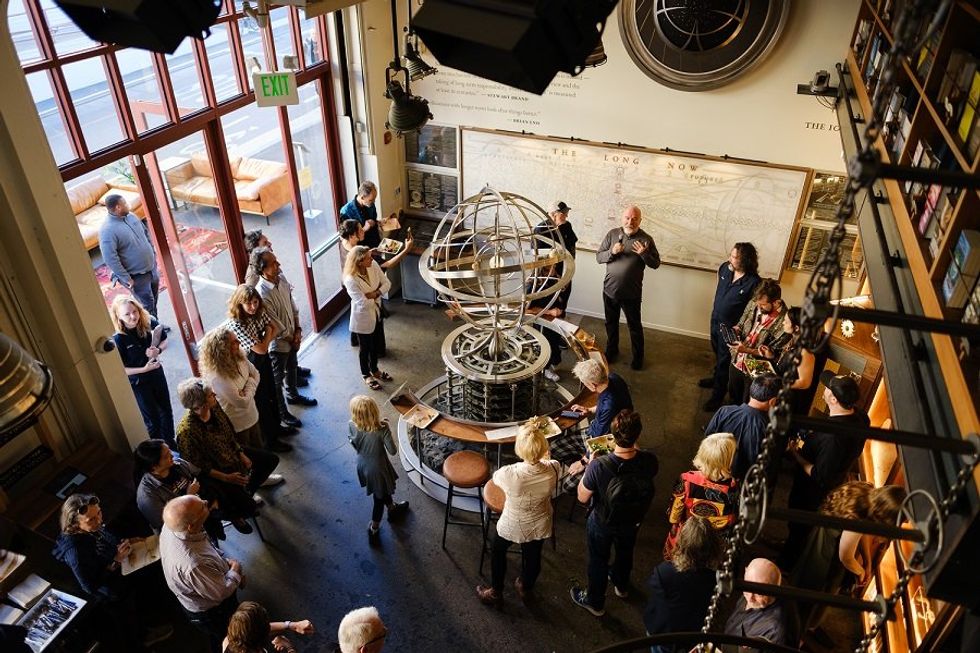
“Over 90 percent of the languages spoken today are expected to go extinct within the next century,” says Warner. “How do you communicate with someone 10,000 years from now with no language in common?”
The solution devised by the Long Now Foundation was inspired by the Rosetta Stone, the more than 2,000-year-old monument that provided the key for deciphering Egyptian hieroglyphs. On the palm-sized Rosetta Disk, 13,000 pages of parallel information (including the Bible’s Genesis 1, the most widely translated text in the world) have been microscopically etched in more than 1,500 languages.
“In theory, entire languages could be built out from the initial sets on the disk,” says Warner. Its more immediate value, though, is to today’s “linguistic endangerment.” According to Warner, research has shown that when a language disappears, it’s like a canary in the coal mine: the disappearance of a region’s cultural and ecological diversity isn’t far behind. The Rosetta Disk preserves a record of existence that could help resurrect it in the future, or at least prevent it from being lost forever.
Several Rosetta Disks have been deposited in libraries across the world, and beyond. Two of them even reside in space, one on the moon, the other on the comet 67P/Churyumov-Gerasimenko. The Interval’s copy is housed in a glass case at the bar’s center, next to the spiral staircase that leads to the crowd-curated Manual for Civilization library. Organized into four broad categories—long term thinking, past and future; rigorous science fiction; the cultural canon; and the mechanics of civilization—the collection will eventually be whittled into about 3,500 volumes permanently housed here and in digital form in the Internet Archive.
It's in the shadow of the library’s stacks that The Interval frequently hosts lectures with some of the world’s most important writers, scientists, and thought leaders. (Larger Long Now–sponsored events also take place regularly, like the upcoming Lost Landscapes at the Herbst Theatre on December 9th). At the bar’s events, thinking and drinking combine with cocktails that, appropriately, also pay homage to the passage of time.
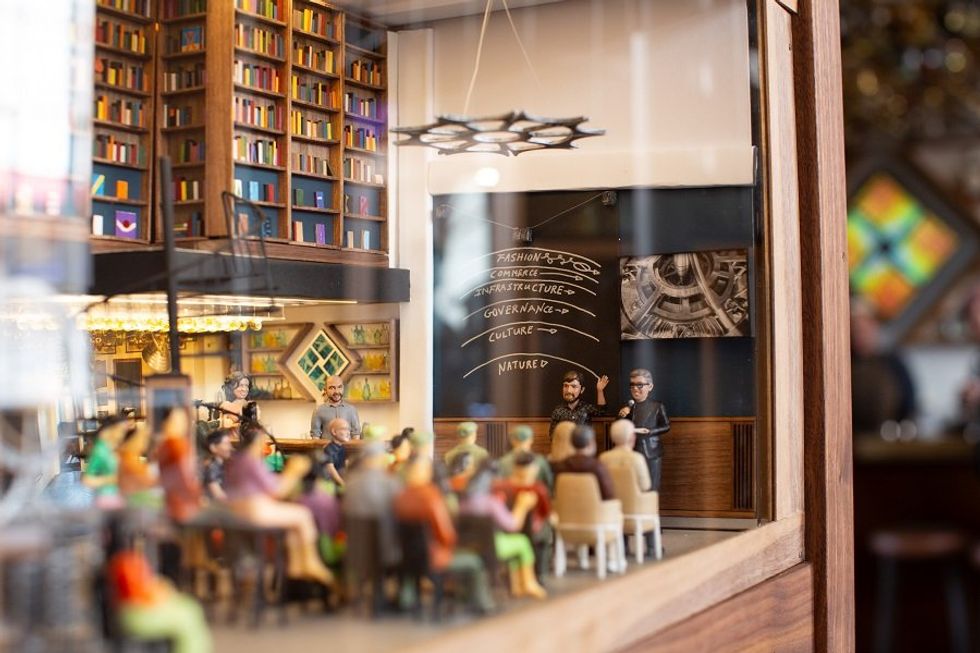
Menus revolve around themes like eternal fads or long-lived institutions, the latter of which included a spiced coffee drink dedicated to Zildjian, the Turkish cymbal and drum brand founded during the Ottoman Empire. In the Time Capsule section are favorites from The Interval’s last decade in business, including “I’ve Grown to Love Life Too Much,” a mix of Cognac, spiced pear liqueur, and creme de cacao served with a side of sparkling wine.
“We’re passionate about the provenance of products and serving things that are a snapshot of a group of people like artisanal Oaxacan mezcal or French Armagnac brandy,” says beverage director Ty Caudle. ABV-free cocktails, as well as beer, wine, and a stellar coffee and tea program featuring Cute Coffee and Song Tea, are also served day and night.
The Long Now Foundation’s core principle, that humans will still be living on Earth in some form 10,000 years in the future just as they were 10,000 years ago, is kind of a radical one, says Warner. With climate change, conflict, and a dozen other threats to humanity in our path, there are some who think it’s only a matter of time—certainly less than 10,000 years—before people no longer inhabit the planet.
The foundation disagrees.
“The long now is a framework of hope,” says Warner. “We think humans have this capability [to last another 10,000 years].”
Thinking in terms of extended time helps to reframe issues like sustainability, diversity, and communication that won’t just affect our children, grandchildren, and great-grandchildren, but the many millennia of humankind to come.
// The Interval at Long Now (Fort Mason), theinterval.org; for more information, to attend an event, or to become a member of the Long Now Foundation, visit longnow.org
